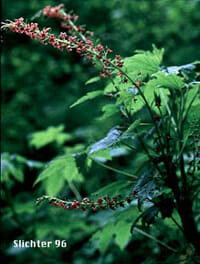Stink Currant – Rosales Saxifragaceae Ribes bracteosum
 |
 |
 |
Identification & Description:
A decidious shrub growing to 2.5m. It is hardy to zone 7. It is in flower in May. The flowers are hermaphrodite (have both male and female organs) and are pollinated by Insects. We rate it 2 out of 5 for usefulness.
The plant prefers light (sandy), medium (loamy) and heavy (clay) soils and requires well-drained soil. The plant prefers acid, neutral and basic (alkaline) soils. It cannot grow in the shade. It requires moist soil.
Habitats and Possible Locations
Woodland, Sunny Edge, Dappled Shade.
Edible Uses
Fruit.
Fruit – raw or cooked. Not very palatable. The fruit can cause stomach upsets if eaten in large quantities. The fruit has a mild blackcurrant flavour, though it is not so juicy, has a mealy texture and a slight bitterness. It ripens in September and is acceptable in small quantities raw, it can also be used in pies, preserves etc and makes an excellent jam. It can be dried and stored for winter use. Native North American Indians considered the fruit to be constipating and so would eat it with oil. The fruit is about 5mm in diameter, it is produced on long racemes, making it much easier to harvest than most currants.